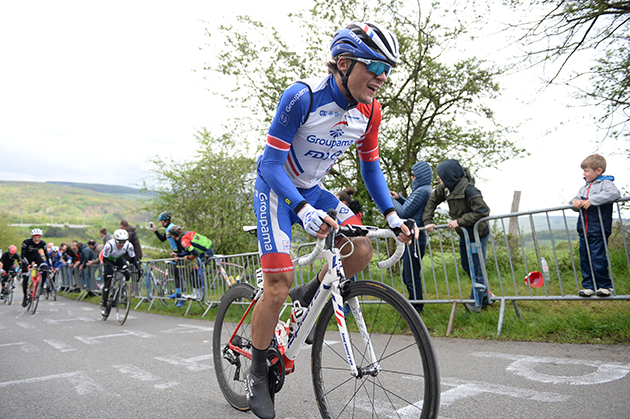Bicycle Racing News and Opinion,
Friday, June 26, 2020
Back to news and opinion index page for links to archived stories | Commentary | Our YouTube page
2019 Tour de France | 2019 Giro d'Italia
The only change is that baseball has turned Paige from a second-class citizen to a second-class immortal. - Satchel Paige

Important upcoming racing, according to the UCI revised calendar:
- August 1: Strade Bianche
- August 5-9: Tour of Poland
- August 8: Milano-San Remo
- August 12-16: Critérium du Dauphiné
Latest completed racing:
- May 1-3:
Vuelta Asturias - May 1:
Rund um den Finanzplatz Eschborn-Frankfurt - April 22-26: Digital Swiss 5
Christian Prudhomme ready for 'unique and singular' Tour de France
Eurosport posted this:
Tour de France race director Christian Prudhomme has explained that the Tour de France safety protocols would be trialled at the Criterium du Dauphine.
Speaking to the AFP, Prudhomme said that detailed plans would be issued later in the summer as the strategies are finalised.

Christian Prudhomme. Sirotti photo
"The guidelines will be defined in late July, early August," Prudhomme said, of what would be a, "unique and singular" event due to the coronavirus pandemic, adding that the Criterium du Dauphine would be used as a test event for guidelines.
Competitive cycling was suspended in the spring of 2020 as the world went into lockdown, but the Tour is now four weeks away. The director confirmed that riders would be asked not to give autographs on the stages, and there will be no traditional kissing on the podium for stage and race winners.
"The public will be able to come to the Tour but there will probably be more or less strict security. In the mountains, we will favour those who go up on foot, by bike or on the transport set up by the communities. But, I repeat, the situation is changing from day to day. What will it be in two months?" Phrudhomme explained.
"What we can say is that there will be a race with the best riders. The publicity caravan will have about 100 vehicles, about 60 per cent of previous years. The economic crisis is hitting the various sectors of the economy."
The director also believes that the weather will have a huge impact on the Tour due to the exacting conditions caused by the summer heat.
You can read the entire story here.
A talk with Groupama-FDJ coach David Han
The team posted this:
Roughly a month after the end of the lockdown – in France -, and approximately a month before the first races, the Groupama-FDJ cycling team’s riders are now in the heart of their preparation for the end of the 2020 season. It is then a perfect timing to take stock with one of the team’s coaches, David Han, who has actually taken a short trip across France to visit his protégés.
David, you went to meet – and ride with – some of your riders these past few days. What was the purpose?
There are a few of them. I wanted to do this for a couple years in order to know some riders’ environment, to discover their training roads and to better understand their approach to their work from day to day. It is something that came back to me during the lockdown when Olivier [Le Gac] told me that he was redoing his terrace. Three years ago, I went to his place for a coffee, so I could easily picture it. On the other hand, this is something I could not do at all for the others, so that was the first reason. The second objective was to enable them to reconnect directly with someone of the team. In their careers, they have rarely spent four months without seeing a member of the organization. Moreover, we could also sit down together in a different way than what it is done during a training camp or a race. As such, it was a slightly more personal visit.
Did this require any particular logistics?
Due to the various restrictions, I can only visit the six Frenchmen that I supervise. I already met with the three Brittany’s riders (David Gaudu, Valentin Madouas, Olivier Le Gac), Bruno Armirail and Marc Sarreau. I will drop by Léo Vincent next week as I have a meeting in Besançon. I only stayed in two hotels in a week-time. All the riders spontaneously offered me to eat and sleep at their place. I had quite a trip to go see Bruno in Bagnères-de-Bigorre from Brest, and then drive back up to Marc’s. Bruno took me three days just by himself (smiles), but from the moment I was visiting the others, I couldn’t see myself telling Bruno that I was not coming to his place because he was too far away.

Valentin Madouas is one of the riders David Han coaches. Sirotti photo
The point was more to strengthen the bond than monitoring the training?
Yes, and as I said, it was something I always wanted to do but I never had time for it. It’s not easy to do this in high season because of everyone’s availability. This time, it lent itself really well and we had to take advantage of the circumstances. We could then benefit to physically find ourselves with someone else of the team, even if the exchange was not really different in itself. With the riders, we’ve often called each other on FaceTime, and that allows for a slightly stronger relationship than with a simple phone call. Above all, they were happy to show me their training roads and where they live.
Did visualizing their “playground” bring you anything?
I let them be free to show me their favourite roads, or the places where they usually do their exercises. For example, I was pleasantly surprised by Olivier’s very hilly playing field, which can partly explain his natural climbing progression over the past two years. On social networks, I also often saw Bruno climbing the Aspin or the Tourmalet and thought he was doing that all the time. He then said to me “you’ll see, the Aspin isn’t that hard”. So we went there, and it’s true that, apart from five difficult kilometers, it is quite accessible. Marc also showed me the area where he currently lives and the more hilly part where he will be in a few months. I was then able to picture the terrain, the roads, and that allows me to better understand some things and also imagine the exercises that I will be able to suggest them in the future. I think it will unconsciously comes into my thinking; maybe I will give them a positive elevation to reach, or plan them more or less difficult rides depending on whether I send them East or West. I’m going to be able to play with these factors.
Besides planning sessions and analysing data, is the individual support essential to the relationship between a trainer and his rider?
It definitely goes further than the simple sporting aspect. As Fred [Grappe] often says, we don’t necessarily have to be personally attached to the riders, but at the same time, we are not only coordinators who exist to give and receive. I think there is a very important human side. From this point of view, being able to understand everyone’s family environment, without being intrusive, also proved to be useful. I also think it was important to meet again and to quietly sit down. It was pretty good since they’ve been communicated their races schedule at the beginning of last week. We have therefore already been able to plan the next few months and imagine some things to implement. We could just as easily have done it remotely, but it’s more pleasant and more efficient to do it together in front of a computer, in peace.
How much has the training monitoring increased since they returned on the road?
At the start of the lockdown, the team decided not to make a training plan and to let the riders rest for about two weeks. They then resumed with Zwift sessions. It was new to them, but also to me in terms of session planning. It was also complicated to plan anything until we get more information about the calendar, and as a consequence, it was not a period during which we had a lot of work in terms of sessions planning and analysis. On the other hand, it allowed us to get us up to date on certain statistics, to look for areas of improvement. We must admit that it was not a very intense period and that we were not overwhelmed with work. When they got back on the road, they started off again gradually as we did not know how everyone would react after two months without training on the road. Since early June, we really got back into a pre-season pattern, as we can experience in January, with big sessions, more specific ones, and precise analysis. Working is now at its peak.
Did you have to adjust the plans according to every rider?
Totally. It was individualized for everyone; we adapted the main guideline according to what everyone had done during the two months. My riders, for example, had a different approach to their return on the road. Some preferred to take a 5-6 days break and resume directly on the road. Others preferred to get back on the trainers to better handle the transition with the road. And then, they did not experience the road recovery in the same way. Some had muscular problems and had to take more time, while others felt good immediately but also suffered a little setback later on.
From the start, it was a case-by-case treatment. Since we got back to more intensive exercises, the returns have also been completely different. I had very opposites cases. Some have had a lot of trouble, and conversely, others came close to their record on certain kinds of efforts. It is also due to the way everyone experienced the lockdown, what they did on the trainers and their ability to commit mentally in order to dig deep in training. There are no identical cases but it has started to equalize in recent days. After a few good weeks of work, their level is gradually getting close to that which they will have in races. We are still in the progression process and all that will be refined with the July training camps. In terms of basics and workloads, they now are more or less at the same point. No one is really late.
Since you were comparing this period to the winter preparation, what differences can be emphasized?
There are many parameters. First, in winter, they usually take a break of at least four or five weeks. This time, they took a two-week break, admittedly, but they still stayed fit with the trainers. Therefore, they don’t have to catch up as much as usual. The other very important aspect is the weather, which is naturally much better than in the winter. Psychologically, it’s also different, because although they took a two-week break, they stayed the course and maintained a mental activity. When they stop over the winter, they ‘’unplug’’ both physically and mentally. It wasn’t really the case this time. These are the three main parameters. In theory, this can allow them to get in shape faster than they normally do, but we wanted to keep the same pattern as usual in terms of progression timing. However, the circumstances mean that we will have, I think, very good surprises, and perhaps less good ones, during the course of the races. Mentally, they will need to be really involved when racing resumes and we do not know how everyone will react. It could be destabilizing for some, even if they are all professional and that it should go well overall. In any case, it has undoubtedly been good for some to relax with the family for four months. It is something that they probably hadn’t had the opportunity to do for 10-15 years.
Is it also already time to fit the training to everyone’s programs?
For some, like most of the Tour riders, there are no surprises. For the others however, we will now be able to adjust the training since we know their program. The difference with what we usually know, when some resume in Australia, La Marseillaise or the UAE Tour, is that they will all more or less return at the same time, within ten days. We therefore know that it will be necessary to have a competitive team level from August 1st. Then, according to the Grand Tour planned, it is obvious that they won’t all approach August in the same way. We tried to build programs based on the objectives that we can set for each rider. The approach will obviously be different for Arnaud than for Thibaut, or for others. Also, not all of them get in shape at the same time and in the same way. Not everyone should be in great shape at the end of the training camps. We will also adjust to this.
Overall, are you confident that the riders will regain their level over these three months?
I think everyone will experience a prosperous period and a more difficult one. Doing three months at the top level is difficult since it is not the pattern they are used to. They are more used to work in anticipation to a three to four weeks period, which comes before a recovery phase. This time, the races will come one after the other so the recovery will be different. We have already discussed this with the sports directors and we know that some riders may not be as good on some races. If that happens, it will therefore be necessary that the staff as well as the riders themselves accept these few days “off”. But in the end, everyone will benefit from a prosperous period where they will regain their best level, that is for sure.
Bike industry confidence rising as sales boom
Bike Europe posted this:
DOETINCHEM, the Netherlands – Media reports on massive consumer demand for bicycles and e-bikes in combination with a rapidly number of orders gives the industry full confidence for the future. This is in full contrast with the outlook only a few months ago at the start of the corona lockdown.
Last March, shortly after the impact of the lockdown became clear, only 44% of the industry said it was likely to certain to survive the crisis. In May this number increase already to 76%. This was reported yesterday by Sports Marketing Surveys, the agency who performed a ‘coronavirus business impact survey’. The survey was designed and implemented by experts from Cycling Industries Europe member companies who are setting up a Market Impact and Intelligence Expert Group for the association. All members of Cycling Industries Europe were invited to participated in the survey. The result of the latest edition of the survey were announced during a webinar yesterday.
According to Sports Marketing Surveys the cycling business is currently going against the trend. Compared to other industries, like sporting goods, the cycling industry is more confident about the near future. Still the surveys show the overall revenues are still in decline, although the impact becomes less severe. In March the average revenue change was still – 21% compared with March 2019. In May this number had already dropped to – 12%. As a result, companies are still cautious about spending on staff, marketing and investments but much less than in March. The drop in investments in March was still – 33% versus – 5% in May.
You can read the entire story here.
Back to news and opinion index page for links to archived stories | Commentary









